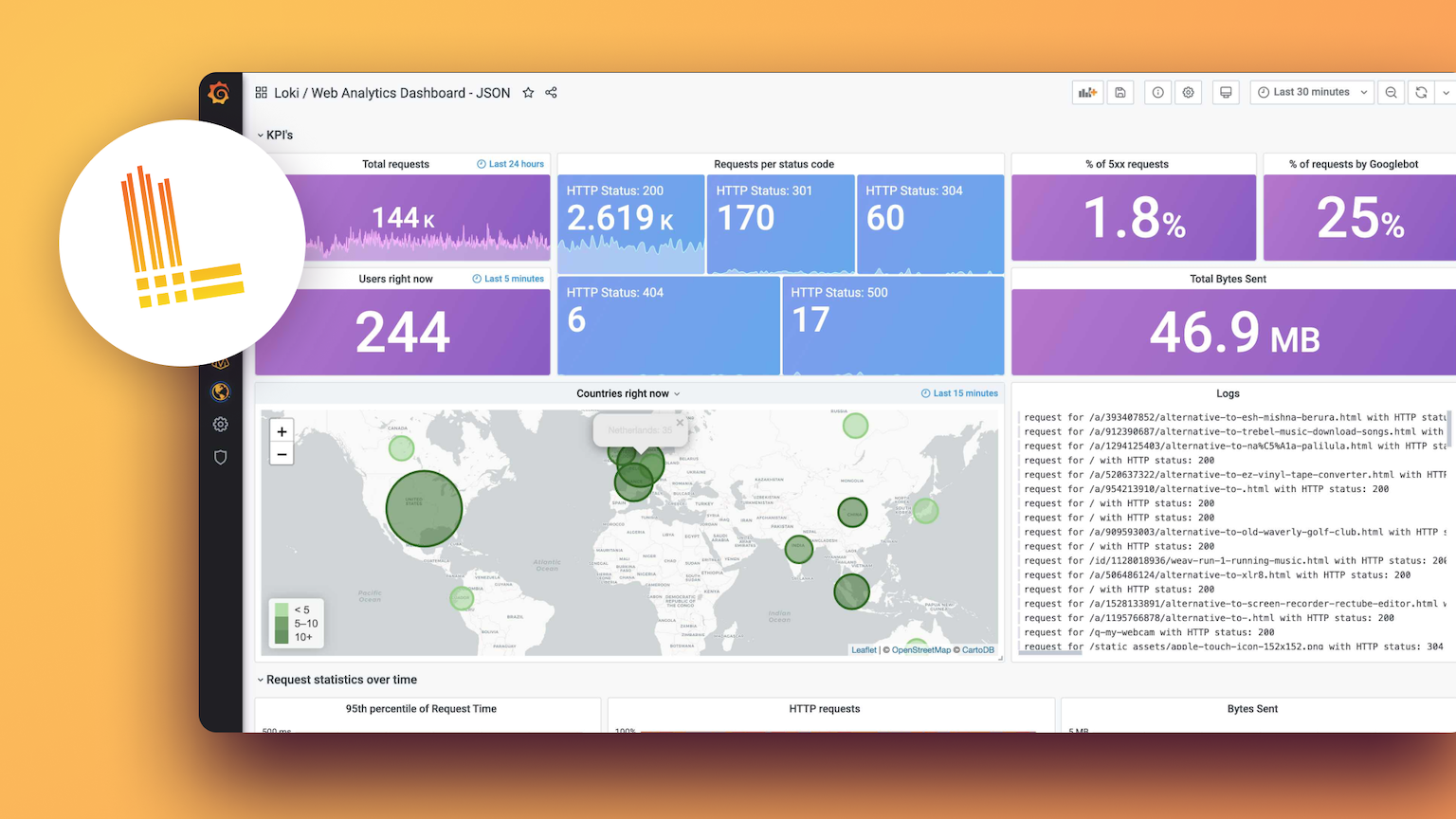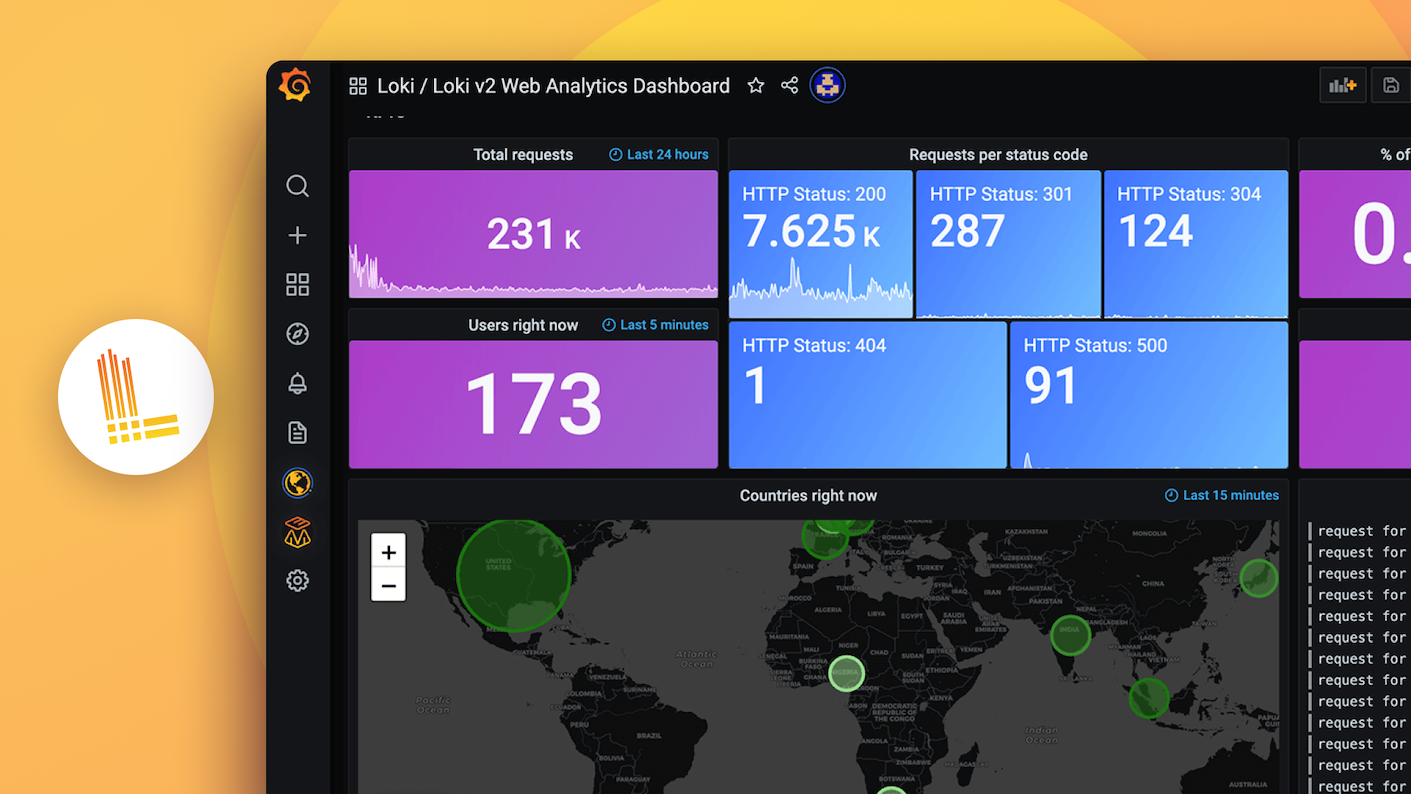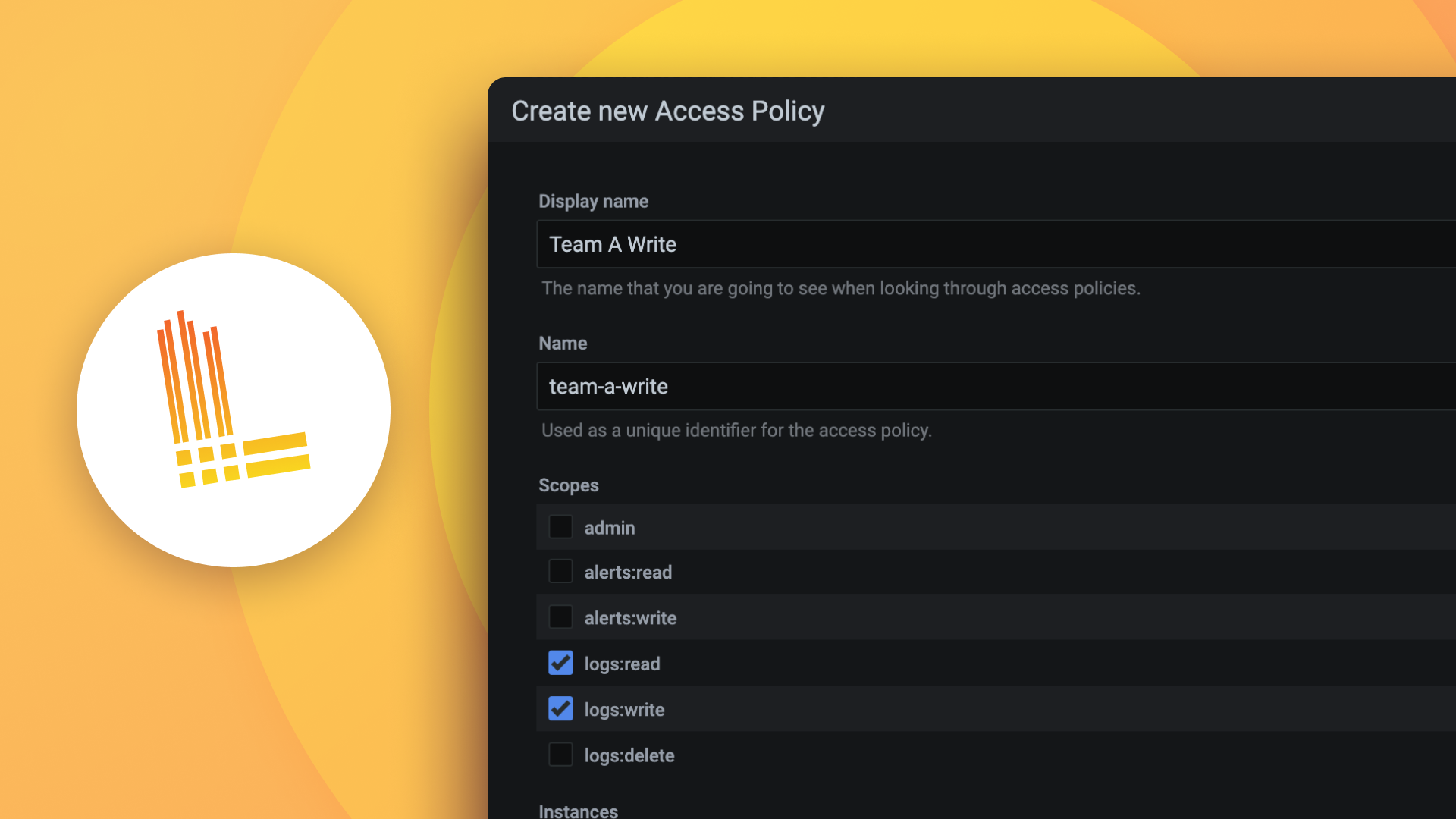存储
与其他日志系统不同,Grafana Loki 的构建理念是只索引日志的元数据:标签(就像 Prometheus 标签一样)。日志数据本身被压缩并以 chunk 的形式存储在对象存储中,例如 S3 或 GCS,甚至可以存储在本地文件系统上。小型索引和高度压缩的 chunk 简化了操作并显著降低了 Loki 的成本。
Loki 2.8 引入了 TSDB 作为 Single Store 的一种新模式,现已成为在 Loki 中持久化数据的推荐方式。有关 TSDB 的更多详细信息,请参阅管理章节。
Loki 2.0 引入了一种名为“boltdb-shipper”的索引机制,这就是我们现在称之为Single Store 的模式。这种类型只需要一个存储,即对象存储,用于同时存储索引和 chunk。有关“boltdb-shipper”的更多详细信息,请参阅管理章节。
在 Loki 2.0 之前,chunk 和索引数据存储在不同的后端:chunk 数据使用对象存储(或文件系统),索引数据使用 NoSQL/键值数据库。这些“多存储”后端已被弃用,如下所述。
您可以在管理章节中找到所有存储选项的更多详细信息。
Single Store
Single Store 指使用对象存储作为 Loki 索引及其数据(“chunk”)的存储介质。支持两种模式
TSDB(推荐)
从 Loki 2.8 开始,TSDB 索引存储提高了查询性能,降低了总拥有成本 (TCO),并且与“boltdb-shipper”具有相同的功能奇偶性。TSDB 是 Loki 2.8 及更新版本的推荐索引存储。
BoltDB(已弃用)
在开发期间也称为“boltdb-shipper”(并且仍然是 schema 的 store 名称)。Loki 的单存储配置使用 chunk 存储来同时存储 chunk 和索引,只需要一个存储即可运行 Loki。BoltDB 是 Loki v2.0.0 到 v2.7x 的推荐索引存储。
性能与专用索引类型相当,同时提供了更经济且更简单的部署。使用 Single Store 时,无需额外的Chunk 存储和索引存储。
支持的存储后端
有关支持的后端,请参阅对象存储。
Chunk 存储
文件系统
文件系统是最简单的 chunk 后端,尽管由于它没有复制,也容易发生数据丢失。这在单二进制部署中很常见,对于试用 Loki 或进行本地开发的用户也是如此。它在概念上类似于许多 Prometheus 部署,其中单个 Prometheus 负责监控一组目标。
对象存储
Google Cloud Storage (GCS)
GCS 是 Google 提供的一项托管对象存储服务。它是托管对象存储的良好选择,特别是在您已运行在 GCP 上时,并且是生产环境安全的。
Amazon Simple Storage Service (S3)
S3 是 AWS 的托管对象存储服务。它是托管对象存储的良好选择,特别是在您已运行在 AWS 上时,并且是生产环境安全的。
Azure Blob 存储
Blob 存储是 Microsoft Azure 的托管对象存储服务。它是托管对象存储的良好选择,特别是在您已运行在 Azure 上时,并且是生产环境安全的。您可以通过存储帐户名称和密钥或使用服务主体来认证 Blob 存储访问。
IBM Cloud Object Storage (COS)
COS 是 IBM Cloud 托管对象存储服务。它是托管对象存储的良好选择,特别是在您已运行在 IBM Cloud 上时,并且是生产环境安全的。
百度对象存储 (BOS)
BOS 是百度云托管对象存储服务。
阿里云对象存储服务 (OSS)
OSS 是阿里云托管对象存储服务。
其他值得一提的选项
您可以使用任何可替代的服务,例如实现 S3 API 的服务,如 MinIO。
Cassandra(已弃用)
Cassandra 是一个流行的数据库,也是 Loki 可能的 chunk 存储之一,并且是生产环境安全的。
注意
此 chunk 存储类型已弃用,并可能在 Loki 未来的主要版本中移除。
索引存储
Cassandra(已弃用)
Cassandra 也可用于索引存储,除了boltdb-shipper 之外,它是唯一可用于索引的非云服务,具有横向伸缩性和可配置的复制。如果您已经运行 Cassandra,或者在本地部署,或者不想使用托管云服务,它是一个不错的选择。
注意
此索引存储类型已弃用,并可能在 Loki 未来的主要版本中移除。
BigTable(已弃用)
Bigtable 是 Google 提供的一项云数据库服务。如果您已经在 GCP 中运行或希望在 GCP 中运行,并且已经在使用它(由于其高昂的固定成本),它是一个不错的托管索引存储选择。
注意
此索引存储类型已弃用,并可能在 Loki 未来的主要版本中移除。
DynamoDB(已弃用)
DynamoDB 是 AWS 提供的一项云数据库服务。它是一个不错的托管索引存储选择,特别是如果您已在 AWS 中运行。
注意
此索引存储类型已弃用,并可能在 Loki 未来的主要版本中移除。
速率限制
DynamoDB 容易受到速率限制的影响,特别是由于过度消耗所谓的预置容量。这可以通过表管理器中的provisioning 配置来控制。
BoltDB(已弃用)
BoltDB 是一个磁盘上的嵌入式数据库。它没有复制,因此不能用于高可用性或集群 Loki 部署,但通常与 filesystem chunk 存储搭配使用,用于概念验证部署、试用 Loki 和开发。boltdb-shipper 旨在支持使用 boltdb 作为索引的集群部署。
注意
此索引存储类型已弃用,并可能在 Loki 未来的主要版本中移除。
Schema 配置
Loki 旨在实现向后兼容,在其开发过程中进行了许多内部更改,以促进更好、更高效的存储/查询。Loki 允许逐步升级到这些新的存储 schemas,并且可以透明地跨它们进行查询。这使得升级变得轻而易举。例如,从 2023-07-01 开始,从使用 v11 schema 的 BoltDB 迁移到使用 v13 schema 的 TSDB 的配置如下所示
schema_config:
configs:
- from: 2019-07-01
store: boltdb
object_store: filesystem
schema: v11
index:
prefix: index_
period: 24h
- from: 2023-07-01
store: tsdb
object_store: filesystem
schema: v13
index:
prefix: index_
period: 24h对于 2023-07-01 之前摄入的所有数据,Loki 使用了带有 v11 schema 的 BoltDB,之后切换到使用 v13 schema 的更有效的 TSDB。这极大地简化了升级,确保可以轻松利用新的存储优化。这些配置应该保持不变,只要您关注数据保留。
表管理器(已弃用)
Loki 中的一个子组件是 table-manager。它负责预创建和过期索引表。这有助于将 Loki 的写入和读取分散到一组不同的索引中,以防止无限制增长。
table_manager:
# The retention period must be a multiple of the index / chunks
# table "period" (see period_config).
retention_deletes_enabled: true
# This is 15 weeks retention, based on the 168h (1week) period durations used in the rest of the examples.
retention_period: 2520h更多信息,请参阅表管理器文档。
Provisioning
对于 AWS DynamoDB,您可能还需要调整表的预置吞吐量。这既是为了防止表被速率限制,也是为了避免不必要的成本。默认情况下,Loki 为 DynamoDB 表使用如下预置容量策略
table_manager:
index_tables_provisioning:
# Read/write throughput requirements for the current table
# (the table which would handle writes/reads for data timestamped at the current time)
provisioned_write_throughput: <int> | default = 3000
provisioned_read_throughput: <int> | default = 300
# Read/write throughput requirements for non-current tables
inactive_write_throughput: <int> | default = 1
inactive_read_throughput: <int> | Default = 300请注意,还有其他 DynamoDB provisioning 选项,包括 DynamoDB 自动扩展和按需容量。有关更多信息,请参阅 table_manager 块文档中的provisioning 配置。
升级 Schemas
当新 schema 发布并且您想利用它带来的优势时,您可以做到!Loki 可以透明地跨 schema 边界查询和合并数据,因此不会中断服务,升级也很容易。
首先,您需要在 schema_config 中创建一个新的 period_config 条目。这里要记住的重要一点是,将其设置在未来某个时间点,然后将配置文件更改部署到 Loki。这使得表管理器能够在写入之前提前创建所需的表,并确保现有数据不会按照新 schema 的方式查询。
例如,假设现在是 2023-07-14,您想在 20 号开始使用 v13 schema
schema_config:
configs:
- from: 2019-07-14
store: tsdb
object_store: filesystem
schema: v11
index:
prefix: index_
period: 24h
- from: 2023-07-20
store: tsdb
object_store: filesystem
schema: v13
index:
prefix: index_
period: 24h就是这么简单;您刚刚创建了一个从 20 号开始的新条目。
保留
除了 filesystem chunk 存储之外,Loki 不会删除旧的 chunk 存储。这通常通过在您选择的 chunk 存储中配置 TTL(生存时间)来处理(S3/GCS 中的存储桶生命周期,以及 Cassandra 中的 TTL)。目前,当使用 filesystem chunk 存储并且本地磁盘已满时,Loki 也不会删除旧数据——删除仅由保留时长决定。
我们有兴趣在未来的 Loki 版本中添加有针对性的删除(考虑租户或流级别的粒度),并且也可能包含其他策略。
更多信息,请参阅保留配置文档。
示例
单机/本地开发 (boltdb+filesystem)
仓库包含一个可工作的示例,您可能需要 checkout 仓库的某个标签以确保获得兼容的示例。
GCP 部署 (GCS Single Store)
storage_config:
tsdb_shipper:
active_index_directory: /loki/index
cache_location: /loki/index_cache
cache_ttl: 24h # Can be increased for faster performance over longer query periods, uses more disk space
gcs:
bucket_name: <bucket>
service_account: |
{
"type": "service_account",
...
}
schema_config:
configs:
- from: 2020-07-01
store: tsdb
object_store: gcs
schema: v13
index:
prefix: index_
period: 24hservice_account 应包含来自 GCP Console client_credentials.json 文件或 GCP 服务帐户密钥的 JSON。如果此值为空,大多数服务将回退到 GCP 的 Application Default Credentials (ADC) 策略。有关 ADC 的更多信息,请参阅Application Default Credentials 工作原理。
预定义的 storage.objectUser 角色(或基于它建模的自定义角色)包含 Loki 运行所需的足够权限。
注意
GCP 建议使用工作负载身份联合而不是服务帐户密钥。
AWS 部署 (S3 Single Store)
storage_config:
tsdb_shipper:
active_index_directory: /loki/index
cache_location: /loki/index_cache
cache_ttl: 24h # Can be increased for faster performance over longer query periods, uses more disk space
aws:
s3: s3://<access_key>:<uri-encoded-secret-access-key>@<region>
bucketnames: <bucket1,bucket2>
schema_config:
configs:
- from: 2020-07-01
store: tsdb
object_store: aws
schema: v13
index:
prefix: index_
period: 24h如果您不想硬编码 S3 凭据,也可以通过修改 storage_config 部分来配置 EC2 实例角色
storage_config:
aws:
s3: s3://region
bucketnames: <bucket1,bucket2>该角色应附加具有以下权限的策略。
{
"Version": "2012-10-17",
"Statement": [
{
"Sid": "LokiStorage",
"Effect": "Allow",
"Principal": {
"AWS": [
"arn:aws:iam::<account_ID>"
]
},
"Action": [
"s3:ListBucket",
"s3:PutObject",
"s3:GetObject",
"s3:DeleteObject"
],
"Resource": [
"arn:aws:s3:::<bucket_name>",
"arn:aws:s3:::<bucket_name>/*"
]
}
]
}要设置 S3 存储桶以及 IAM 角色和策略
本指南假设已预置了 EKS 集群。
Checkout Loki 仓库并导航到 production/terraform/modules/s3。
初始化 Terraform
terraform init。如果尚未导出,请导出 AWS profile 和区域
export AWS_PROFILE=<profile in ~/.aws/config> export AWS_REGION=<region of EKS cluster>将 OIDC 提供者保存在环境变量中
oidc_provider=$(aws eks describe-cluster --name <EKS cluster> --query "cluster.identity.oidc.issuer" --output text | sed -e "s/^https:\/\///")有关创建提供者的指南,请参阅IAM OIDC 提供者指南。
应用 Terraform 模块
terraform -var region="$AWS_REGION" -var cluster_name=<EKS cluster> -var oidc_id="$oidc_provider"注意,存储桶名称默认为
loki-data,但可以通过bucket_name变量更改。
Azure 部署 (Azure Blob 存储 Single Store)
使用帐户名称和密钥
schema_config:
configs:
- from: "2020-12-11"
index:
period: 24h
prefix: index_
object_store: azure
schema: v13
store: tsdb
storage_config:
azure:
# Your Azure storage account name
account_name: <account-name>
# For the account-key, see docs: https://docs.microsoft.com/en-us/azure/storage/common/storage-account-keys-manage?tabs=azure-portal
account_key: <account-key>
# See https://docs.microsoft.com/en-us/azure/storage/blobs/storage-blobs-introduction#containers
container_name: <container-name>
use_managed_identity: <true|false>
# Providing a user assigned ID will override use_managed_identity
user_assigned_id: <user-assigned-identity-id>
request_timeout: 0
# Configure this if you are using private azure cloud like azure stack hub and will use this endpoint suffix to compose container and blob storage URL. Ex: https://account_name.endpoint_suffix/container_name/blob_name
endpoint_suffix: <endpoint-suffix>
# If `connection_string` is set, the values of `account_name` and `endpoint_suffix` values will not be used. Use this method over `account_key` if you need to authenticate via a SAS token. Or if you use the Azurite emulator.
connection_string: <connection-string>
tsdb_shipper:
active_index_directory: /loki/index
cache_location: /loki/index_cache
cache_ttl: 24h
filesystem:
directory: /loki/chunks使用服务主体
schema_config:
configs:
- from: "2020-12-11"
index:
period: 24h
prefix: index_
object_store: azure
schema: v13
store: tsdb
storage_config:
azure:
use_service_principal: true
# Azure tenant ID used to authenticate through Azure OAuth
tenant_id : <tenant-id>
# Azure Service Principal ID
client_id: <client-id>
# Azure Service Principal secret key
client_secret: <client-secret>
# See https://docs.microsoft.com/en-us/azure/storage/blobs/storage-blobs-introduction#containers
container_name: <container-name>
request_timeout: 0
tsdb_shipper:
active_index_directory: /loki/index
cache_location: /loki/index_cache
cache_ttl: 24h
filesystem:
directory: /loki/chunksIBM 部署 (COS Single Store)
schema_config:
configs:
- from: 2020-10-01
index:
period: 24h
prefix: loki_index_
object_store: cos
schema: v13
store: tsdb
storage_config:
tsdb_shipper:
active_index_directory: /loki/index
cache_location: /loki/index_cache
cos:
bucketnames: <bucket1, bucket2>
endpoint: <endpoint>
api_key: <api_key_to_authenticate_with_cos>
region: <region>
service_instance_id: <cos_service_instance_id>
auth_endpoint: <iam_endpoint_for_authentication>本地部署 (Cassandra+Cassandra)
注意
Cassandra 作为 chunk 和索引的存储后端已弃用。
保留此信息供后人参考,但这可能不是常见的配置。Cassandra 应该可以工作,在某些情况下可能更快,但很可能昂贵得多。
storage_config:
cassandra:
addresses: <comma-separated-IPs-or-hostnames>
keyspace: <keyspace>
auth: <true|false>
username: <username> # only applicable when auth=true
password: <password> # only applicable when auth=true
schema_config:
configs:
- from: 2020-07-01
store: cassandra
object_store: cassandra
schema: v11
index:
prefix: index_
period: 168h
chunks:
prefix: chunk_
period: 168h本地部署 (MinIO Single Store)
您可以使用 AWS 配置来配置 MinIO,因为 MinIO 实现了 S3 API
storage_config:
aws:
# Note: use a fully qualified domain name (fqdn), like localhost.
# full example: http://loki:supersecret@localhost.:9000
s3: http<s>://<username>:<secret>@<fqdn>:<port>
s3forcepathstyle: true
tsdb_shipper:
active_index_directory: /loki/index
cache_location: /loki/index_cache
cache_ttl: 24h # Can be increased for faster performance over longer query periods, uses more disk space
schema_config:
configs:
- from: 2020-07-01
store: tsdb
object_store: s3
schema: v13
index:
prefix: index_
period: 24h


